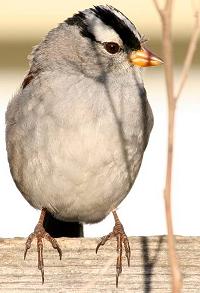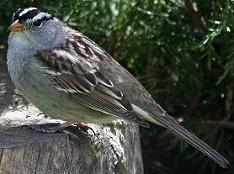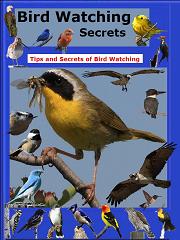White-Crowned Sparrow 
Identification and Pictures
(Zonotrichia leucophrys)
White-crowned sparrows are about 5 1/2
to 7 inches. A white stripe from the bill to the back
of the head, and another over the eye identifies this
attractive bird. Their bill is either pink or
yellow and often has a dusky tip. They have a long
tail, and 2 white bars on the wings. The crown has a puffy look to it.
Their breast is gray. In younger birds the head stripe is more of a brown
color. Both sexes are similar.
There are 5 subspecies, with variations from one area to
anothe, and telling them
apart can be difficult.
Photos by Keith Lee.
The camera I use is the Canon
EOS 40D. Visit All-birds store
Range and Habitat
 White Crowned Sparrows range through
Alaska, Canada, and western U.S. Northern populations may
migrate for the winter to southern U.S. and Mexico. They can be
found in towns, the country, and along roadsides.
Their preferred habitat is low brush, thickets, and
forest edges. Outside of breeding season they
may be seen in flocks with other birds. White Crowned Sparrows range through
Alaska, Canada, and western U.S. Northern populations may
migrate for the winter to southern U.S. and Mexico. They can be
found in towns, the country, and along roadsides.
Their preferred habitat is low brush, thickets, and
forest edges. Outside of breeding season they
may be seen in flocks with other birds.
Breeding and Nesting
Male White-crowned sparrows usually
arrive in the breeding area before females, and sing to
protect their territory, and attract a mate. The
birds are usually monogamous. The female builds a
cup nest of grass, pine needles, twigs, and bark strips,
lined with fine grass, hair, and feathers, on or near the
ground. She will incubate 3 to 5
bluish green, pale, spotted eggs for 11 to 14 days.
Both parents feed the young birds which will leave the
nest in around 10 days. They will be able to fly
and find their own food in 7 to 10 days after leaving
the nest.
Song and Call
Their song is a clear whistles followed
by husky trills. A call often heard is a loud
pink-pink-pink.
Listen to
White Crowned Sparrow
Food and Feeding
Natural foods for Song sparrows are insects, seeds,
and berries, which they forage for in shrubs, and on the
ground, by scratching with both feet to uncover
food. They will visit seed feeders, but prefer to
eat seeds dropped on the ground by other birds.
For more
on food and feeding click here.
For more on feeders click here.
To learn about other
favorite birds click here.

|
|
|
 All-birds Store
All-birds Store
Bird Watching guides, books, binoculars,
cameras, gifts for bird lovers, bird baths, feeders
and more... baths, feeders
and more...
|
|
|
RECOMMENDED READING
Available for Immediate
Download

Click
here
|
|
